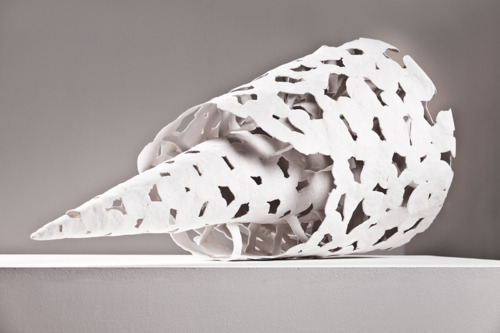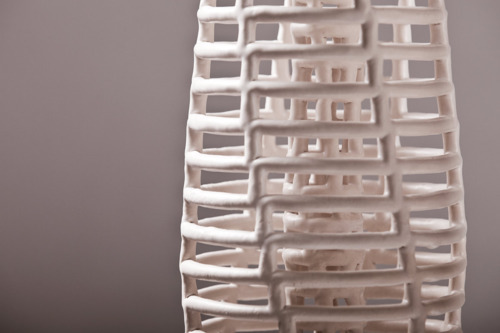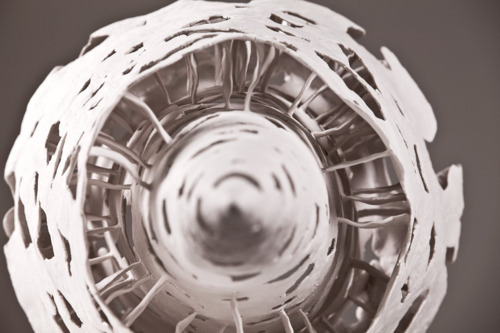
You are a very young and talented ceramic artist. Can you tell us what was your first experience with ceramics?
Thank you, but I’m not that young actually. I studied art in school, liked it very much but never considered it as a possible career. After many years training and working in various environmental management roles, I began to realise how much I missed making art. So, I returned to the University of Ulster in Belfast to do the BA Fine and Applied Arts with a view to specialising in drawing. There, I had a brief introduction to clay, which I had never used before and had an instant connection with it as a material. I loved how malleable it was and how you could so easily transfer a quality of touch during making. I viewed it as an extension of my drawing practice. So, I made an impulsive decision to specialise in ceramics for my Degree after that.
Constructing using hand-building techniques give your works a sense of delicacy and lightness. How do you make your works? Tell us more about the process.
As I mentioned before, I enjoy making where I can transfer a sensitivity of touch to the material. It is important for me that the sculptures maintain a certain immediacy, vibrancy, and vulnerability that can be achieved easily with drawing, but that tends to be lost when making 3-dimensional work. I think this is the case with ceramics, in particular, where so much time and processes are involved. I predominantly choose hand-building techniques such as pinching and coiling so you can build quickly and loosely. I’m not so interested in the perfect surface, and I like to achieve an appearance of the handmade. I like the texture of hammered metal and to leave holes and marks like fingerprints. This gives the work an unfinished aesthetic that adds energy and immediacy to what are seemingly primitive works, but that still feel fresh and relevant.
I wish to heighten the viewer’s awareness of space, air and silence. I am interested in the viewer’s experience and response to objects, particularly the handmade object. I believe that the viewer finishes these forms off in their mind and participates in their making to a certain degree.
In the A Space Apart series, you focus more on the interior of the works and their spaces. What are the series motifs?

Yes, I was interested in the interiority of the pieces and the uncontrolled spaces that presented themselves as part of their making.
In this series, I utilized the Lake-Mountain motif as a way to solidify an abstract, metaphorical space. I read an article some time ago about lakes of water that exist miles beneath the Antarctic ice sheet, kept liquid by the intense pressures of the ice and this image of these trapped spaces always played on my mind. For me, these spaces represent the creative impulse, an impulse that exists despite all else. It is very literally, a positive space.
In the past, I have often used motifs such as the standing stone, spiral staircase, antler and annular form. Motifs are a concise way of conveying meaning, but I don’t rely on them as they can sometimes lack subtlety and feel a little a little obvious.

Double Walled Lattice I, II, III, A Space Apart series
You say that drawing is very important to you and informs your work throughout all stages. Isn’t that sometimes hard to follow? How many sketches do you make when constructing a new piece?
It very much depends on the work. I will always do quick initial drawings in various scales for note taking and problem-solving purposes. Depending on the piece, I will draw during the making stage. For example, if I am making an amalgamated piece such as Travelling Through I may revisit drawing while it’s making to inform scale and form. If I feel a form is particularly strong, I will do more involved drawings, usually with pencil and watercolour, as work in their own right and give them as much attention and prominence as the sculptures.
What form of exhibiting suits you the best? Tell us about your past exhibitions or residencies.
I have exhibited in institutions such as University galleries and at the Craft and Design Collective’s exhibition space, which have been fantastic experiences, but I would like the challenge of responding to a particular space to make and exhibit site-specific work. Also, it may be interesting to create a space for my work in an unexpected location. I think that finding the right space is key to amplify the meaning of the work. In terms of exhibiting experience, I have participated in group and two-person shows, so I am ready for the challenge of a solo show, and I hope that will happen soon.
Exhibitions I respond to are quiet, considered but powerful assemblages of related materials that make different connections, so I hope to develop exhibitions in this way. For me, work doesn’t necessarily need to be plinth-based, and I like a mix of two and three-dimensional work.
I interned as an assistant at the International Ceramic Research Centre, Guldagergaard, Denmark in 2010 where I treated the experience as an artist’s residency making work in my spare time. I loved the variety of people and influences I encountered there along with the luxurious escape from routine.
Where do you get your inspiration from and what motivates you?
In terms of influences I am especially drawn to pure form, objects such as menhirs or standing stones that are rooted in their immediate space, but also draw attention to the space beyond. I like ancient tools and find this language of ancient craftspeople still relevant. I like to make work that is multi-referencing, and that alludes to the past and present. I draw inspiration also from lattice and accreted structures, referencing forms such as industrial turbines, architecture, geological and ice formations and sea-creatures.
I am also influenced by the work of other artists. I equally in awe of and am intimidated by the works of Joseph Beuys and Dorothy Cross, whose amazing use of symbols and materiality I find very inspiring. Having regard to ceramic artists, I learn much from the work of French ceramic and glass artist Bernard Dejonghe whose forms greatly influence my work in terms of material, form and gesture.

Travelling Through – porcelain, feldspar, sand – View her works
How would you characterize the contemporary ceramic art scene in Northern Ireland?
I would say that the contemporary ceramic art scene in Northern Ireland is quite vibrant, with many craft and fine art institutions and galleries demonstrating a major interest in showing ceramics with traditional and sculptural work receiving similar levels of attention. We are lucky to have two major craft institutions, Craft NI and the Craft and Design Collective, who heavily promote ceramics as part of their agenda.
Also, the ceramics department at the University of Ulster has a great reputation and students are showing great interest to study ceramics, so we should expect to see some interesting work emerging from graduates over the next few years.
Where can we find you and your works in the next future?
I am settling into making new work at the moment, I shall hopefully return to Guldagergaard to attend the ‘Project Network’ programme for recent graduates in 2012 and after that I hope to have a solo show. In the meantime, I am happy to work hard and keep my eyes open for interesting opportunities.
“Lying somewhere between contemporary ceramics and sculpture, my work presents a hybrid of both disciplines.
Currently, the work centres on obscure, hidden and uncontrolled spaces that arise through the ceramic making process. I construct using fine hand-building techniques such as pinching and coiling to form thin walls. By making in this way, interesting spaces present themselves while also highlighting the dialogue between the interior and exterior. Lattice-work (alternating bands of supports and rows) enables me to construct delicate structures that are at once open and closed. Often, I use motifs to denote meaning. Drawing is important and informs my work throughout all stages. The objects I make fall somewhere between drawing and sculpture.
Materially, I use a variety of different clays such as porcelain, terracotta and stoneware clays. In particular, I enjoy using porcelain, which I exploit for its delicacy and translucence. Sometimes I introduce a variety of mixed media such as wax. Works range in scale from the intimate to large scale.
I strive towards the qualities of anonymous art. Paring back to pure, multi-referencing and ambiguous elements, I draw influence from concentrated forms such as menhirs, circles and lozenges. Abstract, yet familiar, these are objects that appeal to the archaic content of the mind where the viewer might approach some form of recognition.” Claire Muckian
By Vasi Hirdo.
Published in Ceramics Now Magazine Issue 1.
Visit Claire Muckian’s website.
View Claire Muckian’s profile on Ceramics Now.





















